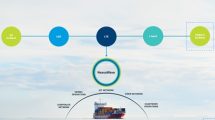By Andrew Faiola, Head of Mobility at ST Engineering iDirect
 Like any other business, shipping organisations are facing intense pressure to operate more efficiently and meet the digital demands of today. The demand for cutting-edge, seamless connectivity has never been higher and although digitalisation is still maturing in the shipping industry, an increasing range of operations and functions are being monitored remotely in real-time or are even becoming automated. Alongside this, officers, crews, ship owners, and managers need simple-to-operate and easy-to-maintain communication services to keep in touch with family. This is a hugely important aspect in ensuring crew morale which is key to good staff retention and safe operations.
Like any other business, shipping organisations are facing intense pressure to operate more efficiently and meet the digital demands of today. The demand for cutting-edge, seamless connectivity has never been higher and although digitalisation is still maturing in the shipping industry, an increasing range of operations and functions are being monitored remotely in real-time or are even becoming automated. Alongside this, officers, crews, ship owners, and managers need simple-to-operate and easy-to-maintain communication services to keep in touch with family. This is a hugely important aspect in ensuring crew morale which is key to good staff retention and safe operations.
However, the solutions that work on land don’t typically operate at sea. The extremely remote locations of ships, plus the fact they are constantly moving bring unique challenges when delivering reliable connectivity that meets the bandwidth requirements of both business operating systems and the crew. Well-known for its ability to be deployed anywhere, quickly and cost-effectively, satellite is the ideal solution that can overcome these challenges and deliver a high-quality and high-capacity service that today’s shipping companies require to enable a digital transformation that will bring enormous business benefits.
Rising tide of demand
As a result of satellite’s suitability and the growing need for digitalisation, demand for the technology is growing rapidly in the shipping industry. In the Middle East specifically, this requirement is primarily being driven by the global oil market, with the region being renowned for its vast oil reserves. The leading producer of oil in the Middle East is Saudi Arabia which produces more than 12 million barrels of oil per day. Following Saudi Arabia’s raising of production, this is only likely to grow, with prices of oil expected to fall. As a result, there has been a dramatic increase in the demand for tankers, all of which need to be connected to ensure daily operations such as remote monitoring.
The issue of crew morale is another factor which continues to receive increased attention, further driving demand for connectivity. Teams working on board container ships depend on satellite connectivity to communicate efficiently and use their own devices and Internet of Things (IoT) applications, which can be a drain on the system, especially if that system is outdated and behind the times. Not giving crew members the connectivity they need can have a damaging impact on morale as it could hinder activities such as accessing familiar content and contacting family and friends at home.
The current COVID-19 crisis underlines the importance of this in a way like never before, especially for the crew on-board vessels. Maersk, one of the largest shipping lines in the world, is one of a number of companies which has suspended crew changes across its fleet to minimise risk to its seafarers and to comply with the current severe restrictions on travel in port states around the world. Additionally, most Middle Eastern ports have restricted or prohibited crew changes, making the lifeline of connectivity that much more important.
Service providers are doing what they can to help crew stay in touch with family and friends and also the world outside. KVH has established new programs to assist seafarers and fleets during the crisis. These programs include free calls to ISWAN’s SeafarerHelp hotline from any KVH VSAT-equipped vessel, free daily news delivery to any commercial ship that requests it whether a KVH customer or not, 50% off crew calling cards so it’s more affordable for crewmembers to stay in touch with home, and up to 50% off data plan upgrades to support expanded bandwidth needs.
For those who remain on-board, sometimes in isolation, connectivity is essential to keep in touch with those back on land. Furthermore, if there is a medical emergency on-board a ship with satellite connectivity it can ensure that the crew are able to speak to medical professionals based on land via video over IP. Otherwise, if a crew member gets injured or is struck down with illness, they may have to call for helicopter assistance or change course to the nearest port. Not only is this costly to the business, but it could endanger lives if the crew cannot reach help in time.
Troubled waters
Clearly connectivity is important – but the practicalities of implementing it are far from simple, even when dealing with a technology as flexible as satellite. Some of the challenges shipping companies have to contend with include unpredictable weather conditions where if a business is using a legacy communications system, it could add additional strain to a business’ operational efficiency. It can also add an element of risk to the ship’s crew and cargo if the latest electronic charts, weather information, or security measures are not at hand.
It is also imperative that container shipping companies can contact those at sea to not only ensure they are on course for their designated mission-critical projects but also that they are safe in the field. Monitoring all the vessels in a container shipping fleet is equally important as the business needs to be able to track and locate them in real-time. Fleets not utilizing the optimal connectivity mix could be holding themselves back from maximising their potential.
In addition, having a fully functioning navigation system for container ship crews is of critical importance. A dip in coverage or a loss of broadband signal can have disastrous consequences, as shore-based crews could be sending time-sensitive re-routing directions or important new instructions. Failure to receive these could result in a delay of time-critical deliveries and potentially impede crew safety. Furthermore, crews can also get real-time support from onshore experts to troubleshoot minor issues before they become major problems.
As with crew morale, COVID-19 is also bringing new challenges to the technical operation of shipping logistics and networks. The crisis has led to some delays in shipping, many logistical challenges, and increased demand on the network, with a surge in demand for crew voice and data services.
The digitalisation voyage
In order to overcome the challenges, players in the shipping industry should look to install flexible, future-proof Very Small Aperture Terminal (VSAT) services. Northern Sky Research (NSR) forecasts the maritime industry will have 75,000 VSAT-enabled vessels in use by 2028. This significant growth of more than 20,000 vessels in less than 10 years supports the theory that we’ve reached the tipping point, and slower adopters will be left behind.
And it is clear to see why. Integrating reliable broadband satellite connectivity will ensure that businesses in the maritime industries never miss a beat and that operations are not disrupted by a lull in communications. Fleets that adopt and deploy these services will not only benefit from improved throughput but enhanced IT solutions which can save businesses time and money, improve crew safety and enhance the ship’s day-to-day mission-critical operations.
But it is important that shipping companies remember that not all solutions are created equal – and selecting the wrong type of system could hinder operations and growth. For the best results, companies should select a platform which is both flexible and scalable, while also ensuring the most efficient and cost-effective operation. ST Engineering iDirect’s Newtec Dialog, Evolution and Velocity platforms, for example, allow operators and service providers to offer their services via a single platform, increasing efficiency, scalability and flexibility, while lowering operating expenditure.
There has never been a time when having the right platform is as important, with satellite communications playing an even more crucial role today in keeping crews connected as they remain out at sea for longer periods of time or in self isolation. During this period, organisations are striving to keep a sense of normalcy where possible. Marlink, for example, is offering free minutes for all crew on vessels equipped with Sealink VSAT and short-term bandwidth upgrades on all Sealink packages to cope with the surge of demand for data from crew. The company is also offering free access to the Marlink XChange Media service and introduced a new light version of the XChange Telemed remote healthcare studio which is more quick and easy to deploy.
One world
There is no doubt that broadband satellite offerings will continue to become increasingly popular within the shipping industry as it continues to realise the advantages of choosing to implement connectivity as an enabler to improve all areas of their operations. This will spearhead the digital transformation of container shipping fleets moving forward as businesses race to implement new technologies and applications which will help them steer clear of troubled waters.












Add Comment